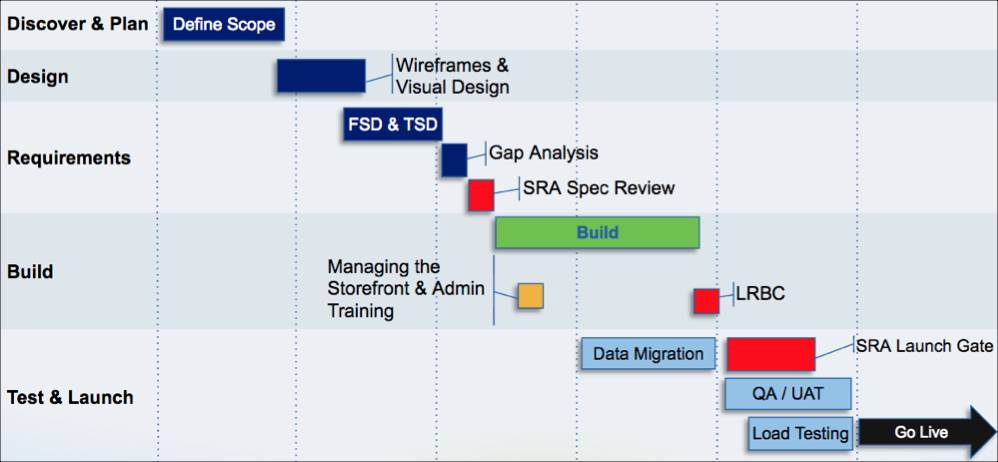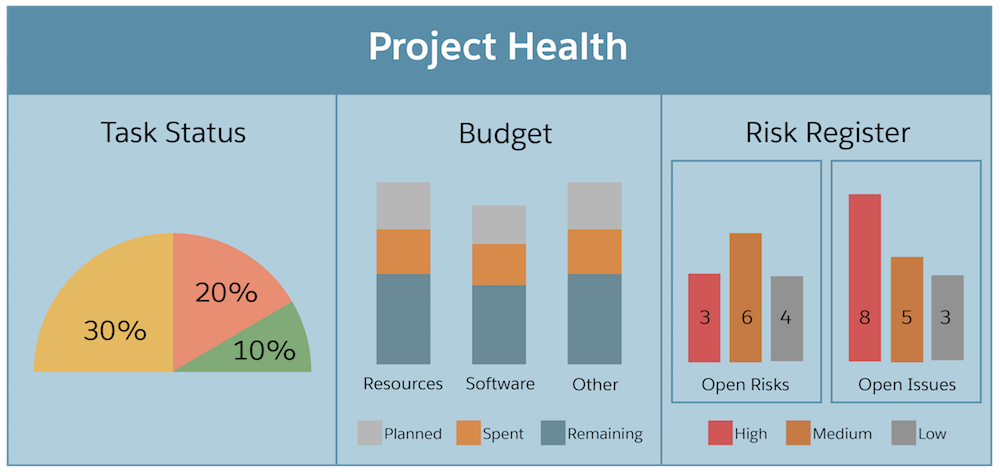Plan the B2C Commerce Implementation
Learning Objectives
After completing this unit, you’ll be able to:
- Explain which milestones to include in a B2C Commerce implementation project plan.
- Identify effective risk-management strategies for B2C Commerce implementation projects.
Craft the Statement of Work
The B2C Commerce Express train is back underway. Between stations, you’ve got time to craft a statement of work (SOW). A clearly-written B2C Commerce implementation project SOW includes essential project details and sets realistic expectations—which increases the likelihood of a successful outcome. At a high level, it accounts for:
- Project-specific activities, deliverables, and timelines
- What’s in scope and what’s not
- Roles and responsibilities for your team, your customer’s team, and third-party teams
- Critical assumptions
To scope the work effort, partners typically use either a fixed scope or a more general outline—a “team and time” approach. Whichever you choose, your SOW must document the core site features you commit to implement. There’s no such thing as a perfect SOW template. But you can find B2C Commerce–specific SOW guidance in the Salesforce Partner Community.
The train is making great progress to the next station. Your team is making even better progress on the project SOW. You take a break to peek at another SOW, the B2C Commerce enablement SOW between you and Salesforce. It lists the total number of Professional Services support hours you purchased from Salesforce. You have ample hours in the bank and redeem a few to have Professional Services look at your project SOW. The Professional Services team double-checks estimates, adds to assumptions, and gives an overall gut check. Their valuable feedback is a risk mitigation essential and well worth the small cost.
They add a few more critical assumptions:
- The project includes an SRA.
- NTO’s business users must complete the Salesforce B2C Commerce Managing the Storefront course.
- NTO is responsible for test data, data validation, and user acceptance testing (UAT) test cases.
Plan the Milestones
There’s a bit more track to cover before you get to the next station. You use the time to work on the project plan. You already know how to create a storefront project plan. Now it’s time to make sure your project plan accounts for all of the typical B2C Commerce–specific milestones.
Project Milestone |
Details |
|---|---|
Site readiness assessment (SRA) reviews |
SRA is the Salesforce B2C Commerce Professional Services team’s ongoing review of the project. It starts at project kickoff and ends at launch. If your customer chooses to add the SRA to the project, they incur an extra charge. The SRA is composed of:
It’s not uncommon to go through two rounds of specification reviews before getting to Launch Gate. |
Design compositions drop schedule |
Design compositions normally involve several rounds of review and revisions. Include enough time to accommodate the full number of rounds you specify in your project SOW. |
Third-party integrations |
If you or your customer plans to use technology partners to incorporate any third-party integrations, include related dates and dependencies. As the PM, it’s your responsibility to gather this information from the customer and third parties. It’s also your responsibility to regularly compare that information to the original project scope to prevent scope creep. If there are delays on your end, be transparent with the SRA owner who was assigned at the SRA kickoff. If your customer misses a deadline, work with Professional Services to help them get back on schedule. |
Managing the Storefront training course |
This course teaches merchants and marketers how to use the Commerce Cloud Business Manager to manage catalogs, products, and promotions for a digital storefront. Have your customer complete the course before or early in the design phase. Customers pay an extra fee to take the course. |
Launch Readiness Bootcamp (LRBC) |
This bootcamp prepares your customer to launch and manage their B2C Commerce storefront. LRBC is part of the SRA. It’s typically conducted 4 weeks before launch. Work with your customer and Salesforce Professional Services to schedule it at the appropriate time. |
Data validation |
Verify test and production data quality and completeness. |
Testing |
Start the conversation about your test phase early in the project lifecycle.
|
Launch sign-off |
Get customer sign-off that the site is ready to launch. Notify Salesforce B2C Customer Support of your impending launch date. |
Check out the timeline that illustrates when some of the milestones are typically addressed.

Mitigate Risk
As the train arrives at the next station, your team finishes the project plan. It’s got exact milestones and dates. It’s perfect. What can possibly go wrong? Most likely, nothing. But, just in case, it’s a good idea to implement risk management strategies.
In an ideal project, it’s easy to balance cost, quality, and time. As a PM, you know that an ideal project is rarely seen in the wild world of consulting. Still, it’s your mission to regularly assess all three elements and keep them in balance.
Use risk mitigation to catch imbalance early. Effective strategies include:
- Communicate status and risk: Chat regularly with your customer, third-party collaborators, and B2C Commerce Professional Services.
- Increase accountability: Clearly and frequently communicate task assignments and deadlines.
- Listen to your team: Allow anyone on the project team to submit a risk.
- Monitor risk: Maintain a project health dashboard that includes a risk register. We recommend a graphical dashboard to easily see if your project is progressing as you expect.

Your customer depends on you to get them to the light at the end of the tunnel. Be the conductor they dream of. Stay positive, provide clear direction, and manage and resolve the risks. Review the Salesforce Risk Management for Delivery Success presentation, to learn more about project risk management.
Risks can pop up at any point in the project lifecycle and for various reasons. However, you can feel good about the mitigation methods you have in place. They keep you on track throughout the project journey and help you manage and resolve risks as they arise.
Plan Deliverables
- Project SOW
- Project plan
- Project health dashboard
Resources
- Salesforce Partner Community: B2C Commerce Storefront Reference Architecture Group (login required)
- Salesforce Partner Community: Salesforce B2C Commerce–specific SOW guidance (login required)
- Salesforce Partner Community: Risk Management for Delivery Success (login required)
- Salesforce Trailblazer Community: Managing the Storefront course registration